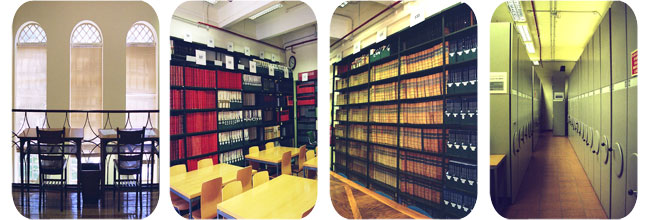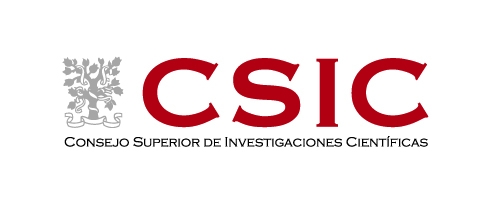| |
The Rocasolano Institute of Physical Chemistry was set up in 1946 at same time as the  . Its holdings come from the "National Institute of Physics and Chemistry" created in 1932. Commonly known as the Rockefeller Institute, on account of a part of building funds were financed by that Foundation, it was the cradle of all the research teams in the different disciplines of Chemistry, not only in Madrid, but throughout Spain. . Its holdings come from the "National Institute of Physics and Chemistry" created in 1932. Commonly known as the Rockefeller Institute, on account of a part of building funds were financed by that Foundation, it was the cradle of all the research teams in the different disciplines of Chemistry, not only in Madrid, but throughout Spain.
The  is regard as a landmark in Spanish scientific history and worthy of the greater protection as a Cultural Good and it could become a "Historic Landmark" due to the importance of its collection of scientific journals. is regard as a landmark in Spanish scientific history and worthy of the greater protection as a Cultural Good and it could become a "Historic Landmark" due to the importance of its collection of scientific journals.

The  holds 842 journal titles, of which 227 are active, 113 are complete starting from the first issue, 11date from the 19th century to our days, and 16 start prior to 1920. Among these old collections-unique in Spain-can be found titles such as: Annalen der Physik, Chemische Berichte, Annalen der Chemie, scientific journals in which the first advances in the German Organic Synthesis are recorded, which were in that moment, the most prestigious in all of Europe. Part of this work was dedicated to the preparation and study of new dyes, which constituted the foundation of Germany’s strong chemical industry which contributed in great measure to the wealth of that Nation. The follow is a small sample of what it can be found in these journals holds 842 journal titles, of which 227 are active, 113 are complete starting from the first issue, 11date from the 19th century to our days, and 16 start prior to 1920. Among these old collections-unique in Spain-can be found titles such as: Annalen der Physik, Chemische Berichte, Annalen der Chemie, scientific journals in which the first advances in the German Organic Synthesis are recorded, which were in that moment, the most prestigious in all of Europe. Part of this work was dedicated to the preparation and study of new dyes, which constituted the foundation of Germany’s strong chemical industry which contributed in great measure to the wealth of that Nation. The follow is a small sample of what it can be found in these journals
 The description of new concepts that revolutionized the theoretical physics: Einstein’s theory of relativity, Heisenberg’s principle of uncertainty, Quantum Mechanics and Schrödinger’s wave equation,etc The description of new concepts that revolutionized the theoretical physics: Einstein’s theory of relativity, Heisenberg’s principle of uncertainty, Quantum Mechanics and Schrödinger’s wave equation,etc
 Theories that lead to new instruments of medical utility: Nuclear Magnetic Resonance, Lasers etc. Theories that lead to new instruments of medical utility: Nuclear Magnetic Resonance, Lasers etc.
 Structural studies and of the synthesis of the ß-lactame, which is the basis of antibiotics such as penicillin. Structural studies and of the synthesis of the ß-lactame, which is the basis of antibiotics such as penicillin.
 The description of preparative methods of organic compounds, hormones, vitamins, antihypertensives, antimalarials, antidepressants, etc. The description of preparative methods of organic compounds, hormones, vitamins, antihypertensives, antimalarials, antidepressants, etc.
 The description and characterization of new materials, which have contributed to the creation of artificial fibres, and materials with improved properties. The description and characterization of new materials, which have contributed to the creation of artificial fibres, and materials with improved properties.
 The synthesis of new catalysts that improve the preparation of chemical materials for industrial applications including petrochemistry, pharmacy, herbicides, food, detergent, cosmetics, etc. The synthesis of new catalysts that improve the preparation of chemical materials for industrial applications including petrochemistry, pharmacy, herbicides, food, detergent, cosmetics, etc.
Moreover, the library possesses specialized serials such as "Advances in Chemical Physics", "Annual Review of Physical Chemistry", important collections like Gmelin, tables, handbooks and other reference books.
Since its genesis, the  was organized in an way that was revolutionary for those days, free access was permitted, and display stands facilitated access to the latest numbers and the previous year’s issues of the journals. For all previously cited, the was organized in an way that was revolutionary for those days, free access was permitted, and display stands facilitated access to the latest numbers and the previous year’s issues of the journals. For all previously cited, the  is considered by the scientific community as the Reference Scientific Periodical Library and is obviously one of the most outstanding scientific libraries in Europe. is considered by the scientific community as the Reference Scientific Periodical Library and is obviously one of the most outstanding scientific libraries in Europe.
|
|

 was organized in an way that was revolutionary for those days, free access was permitted, and display stands facilitated access to the latest numbers and the previous year’s issues of the journals. For all previously cited, the
was organized in an way that was revolutionary for those days, free access was permitted, and display stands facilitated access to the latest numbers and the previous year’s issues of the journals. For all previously cited, the  is considered by the scientific community as the Reference Scientific Periodical Library and is obviously one of the most outstanding scientific libraries in Europe.
is considered by the scientific community as the Reference Scientific Periodical Library and is obviously one of the most outstanding scientific libraries in Europe. 





 The description of new concepts that revolutionized the theoretical physics: Einstein’s theory of relativity, Heisenberg’s principle of uncertainty, Quantum Mechanics and Schrödinger’s wave equation,etc
The description of new concepts that revolutionized the theoretical physics: Einstein’s theory of relativity, Heisenberg’s principle of uncertainty, Quantum Mechanics and Schrödinger’s wave equation,etc